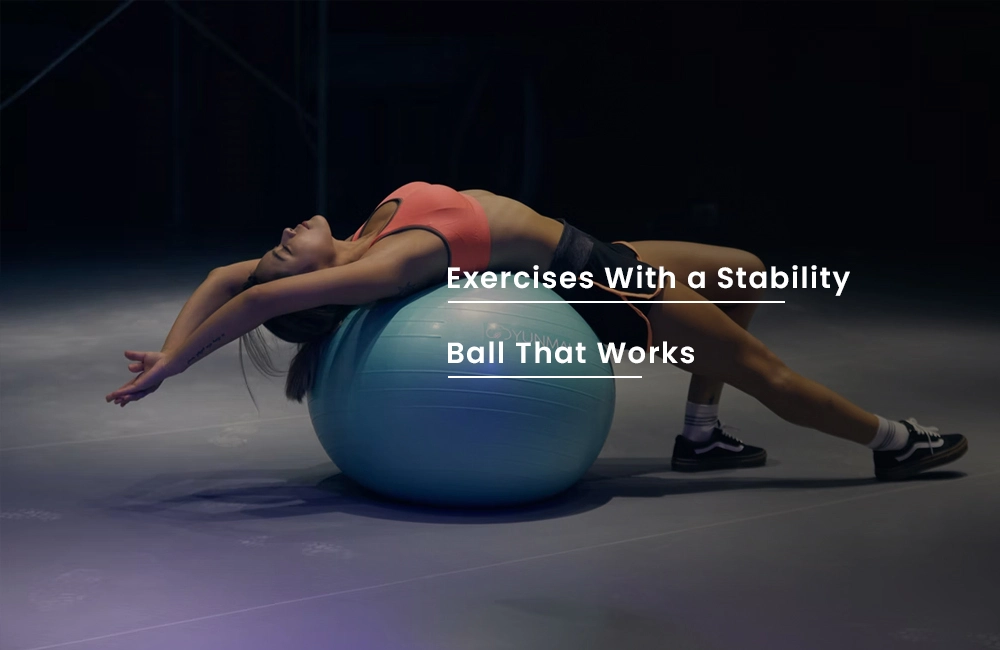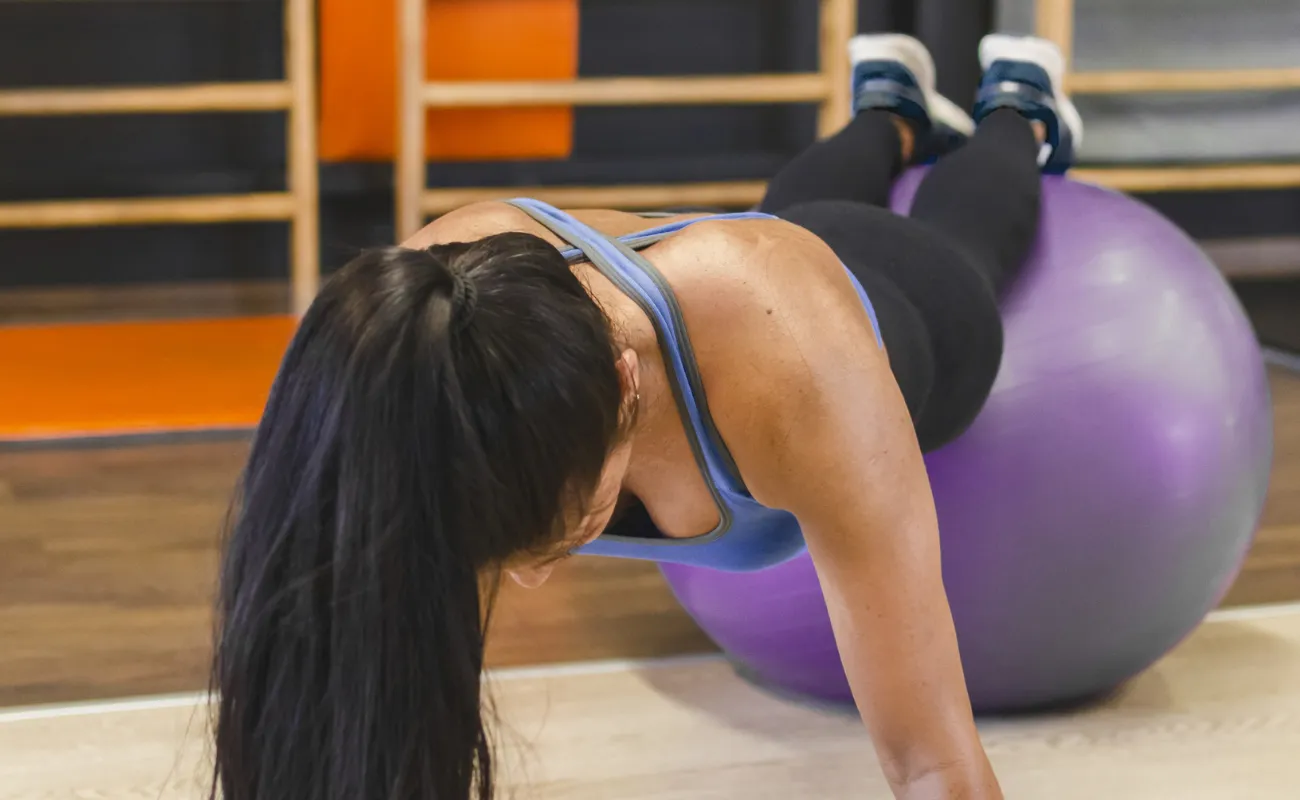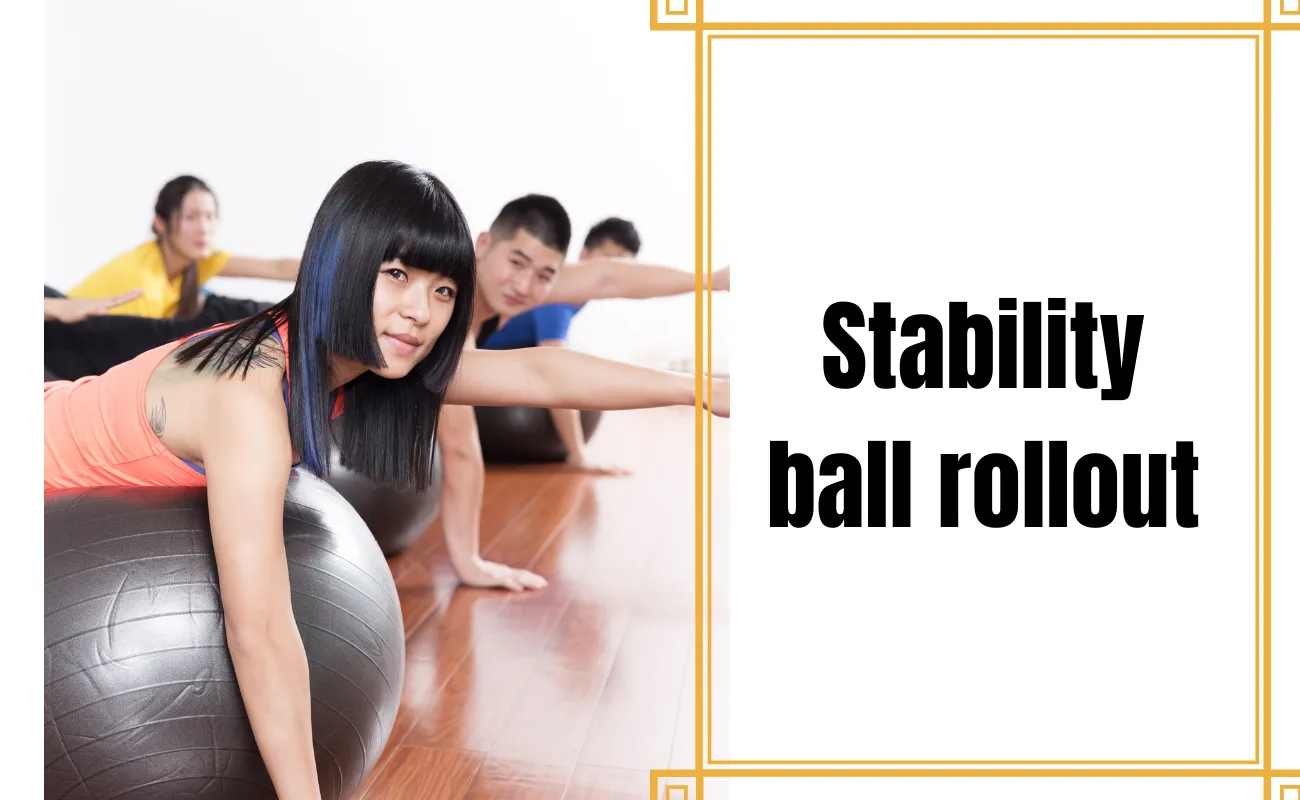“Stability ball workouts educate the body to move as one unit,” says Cody Braun, an Openfit fitness consultant. “The muscles that make up the core and surround the hips and shoulders must work together to maintain the body strength over a complete range of motion when conducting stability ball activities.”
Stability is beneficial in and out of the gym for a variety of reasons. Because they have the strength to stay in the right posture throughout strenuous actions, stable joints are less prone to damage. Furthermore, Braun claims that being able to move your body as a single unit aids weightlifting, jogging, and other athletic efforts.
Exercise Ball Techniques
Are you ready to start shaping muscles and improving your balance? These stability ball workouts may be done at home or the gym.
Jackknife with a stability ball
Benefits: This core exercise strengthens your hip flexors while also squeezing your abs.
- Put your hands exactly behind your shoulders and your shins on top of a stability ball in a high-plank posture.
- Maintain a straight line from head to toes by bracing your core. This is where you’ll begin.
- Squeeze your abs and bend your knees to slide the stability ball toward your hands until just your toes are on it, keeping your hips down.
- Return to the beginning posture by pausing, then gently straightening your legs behind you.
Hamstring curl using a stability ball
Benefits: This easy action strengthens your hamstrings and glutes while also exercising your core.
- Lie flat on your back on the floor with your legs straight and the backs of your calves on top of a stability ball.
- To raise your hips off the floor, brace your core and clench your glutes until your body forms a straight line from shoulders to heels. This is where you’ll begin.
- Roll the ball as near to your butt as possible with your heels dragged until your knees create 90-degree angles.
- Return to the beginning posture by slowly straightening your legs while you roll your feet away from your glutes.
Deadbug with a Stability Ball
Deadbug movements educate your core to perform what it was supposed to do: keep your spine steady while your arms and legs do their job. This variant ups the ante by needing an additional ab squeeze to maintain the stability ball in place, as well as targeting your obliques.
- Lie flat on your back on the floor, arms stretched straight up, legs bent at 90 degrees, and a stability ball between your knees and your hands. This is where you’ll begin.
- Brace your core and steadily drop your right leg and left arm to within six inches of the floor, keeping the ball in place with your right hand and left knee (both should remain in line with your body). Only go as low as you can while forcing your low back against the floor.
- Return to the beginning position by reversing the motion and repeating on the opposite side.
- Continue alternating sides, doing the same amount of repetitions on each side.
See also Burn Calories Fast With Our Fitness Trampoline Workout!
V-pass with a stability ball
Benefits: This next-level stability ball workout will put your entire body to the test. As you transfer the ball between your hands and feet, it engages your core, and you must engage your inner thighs and arms to keep the ball from falling to the ground.
- Lie down with your back flat on the floor and your legs straight on the floor, both hands grasping a stability ball overhead. To reduce any arch in your lower back, brace your core. This is where you’ll begin.
- Squeeze your abs to elevate your arms and legs into a “V” position with the ball between your calves.
- Return to the beginning position but with the ball between your legs this time.
- Rep the action, passing the ball between your hands and legs each time.
Stability decline push-up
Benefits: This difficult bodyweight exercise is a modified decline push-up that works your core as well as your arms. Before doing this exercise, you should be able to confidently complete a set of push-ups. (If you want to improve your push-ups, here are some pointers.)
- Put your hands exactly below your shoulders and your toes on top of a stability ball in a high-plank posture. To hold your body in one straight line from head to toes for the duration of the action, brace your core and clench your glutes.
- Lower your chest toward the ground by bending your elbows while keeping your elbows tucked tight to your body. When viewed from above, they should make a 45-degree angle with your body.
- To return to the plank posture, straighten your arms and repeat.
Stability ball wall squat
Strengthen your glutes, hamstrings, and quadriceps while also strengthening your hips and core. Reps should be done in a row, or each rep should be held for as long as feasible.
- Place a stability ball between the centre of your back and a wall while standing with your feet hip-width apart. Your feet should be positioned slightly ahead of your body. This is where you’ll begin.
- Roll your body down the ball, bending your knees until your thighs are parallel to the floor. Your knees should be parallel to your toes in the center.
- Repeat by pausing, then pressing through your heels to return to the beginning position.
- Holding a dumbbell in each hand makes this motion more difficult.
Russian twist
Benefits: Improve the stability and rotational strength of your core with one easy technique that targets your obliques and transverse abdominis.
Lie on a stability ball with your upper back on it and your feet flat on the floor, knees bent at a 90-degree angle. Maintain a straight line from head to knees by bracing your core and keeping your hips extended.
- Extend your arms straight over your head, palms facing each other. This is where you’ll begin.
- Roll onto one shoulder as far as you can while elevating the other from the ball by rotating your body. Your hips should be parallel to the ground.
- Return to the starting position by reversing the motion.
- Roll onto the opposite shoulder and repeat.
Single-leg stability ball hip thrust
Benefits: By exercising one leg at a time, this advanced hip thrust variant strengthens your glutes and hamstrings, correcting any muscular imbalance between your legs. Using a stability ball instead of a bench concentrates even more on single-leg hip stability. Before moving on to this difficult maneuver, practice with both feet flat on the floor and then both feet on the ball.
- Lie flat on your back with both feet on a stability ball and your legs bent at a 90-degree angle. Place your arms by your sides, straight on the ground.
- Raise one foot off the ball and extend it straight out in front of you.
- To lift your hips off the ground, squeeze your glutes. Make sure your torso is in a straight line from head to knees by bracing your core.
- After a little pause, carefully drop your hips to the ground.
- Complete all repetitions, then switch legs and repeat.
Stability ball “I-Y-T” shoulder raise
Benefits: Train your shoulder stabilizers and mid-back muscles with this surprisingly difficult exercise to counteract the consequences of sitting at a computer all day.
- Lie facedown on a stability ball with your stomach on the ball and your legs straight out behind you, sinking your toes into the floor for support. Make a straight line from your head to your heels by bracing your core.
- Hold your hands in fists with your thumbs up, and let your arms swing straight down to the floor. Squeeze your shoulder blades together and down, away from your ears. This is the point from which you will begin your journey.
- Raise your arms straight up and near to your ears, leading with your thumbs and keeping your shoulders pulled down. The “I” configuration is what it’s called.
- Lower your arms to the floor, then pull them up diagonally to form a “Y” configuration.
- Lower your arms to the floor, then straighten them out to your sides to create a “T” shape with your palms facing the floor.
- The “I-Y-T” cycle is one set.
- Holding a dumbbell in each hand makes this motion more difficult.
Stability ball rollout
Benefits: This easy action will challenge your core strength and stability while shaking your abs.
- Kneel with your legs hip-width apart and your toes on the floor for support, with your hands on a stability ball.
- Slowly roll forward, keeping your back flat and core braced, without shifting your knees until the ball reaches your forearms and your body forms a straight line from your head to your knees.
- Roll back to the starting position after a little pause.
What is the best way to utilize an exercise ball?
An exercise ball can be used in a variety of ways, and it’s a great piece of home gym equipment because it doesn’t take up a lot of room. A stability ball may be used to replace a bench in a variety of exercises. If you’re used to doing exercises on a sturdy bench, Braun notes that utilizing an exercise ball will challenge you to fire up your core, hip, and shoulder stabilizers in a different way. Keep in mind that, because of the increased need for stability, you should begin with less weight than you would on a bench.
Exercises like ab or hamstring rollouts can also be done with stability balls. A stability ball may also be used as a weight (a big, lightweight) that you can transfer from one side of your body to the other or pass between your hands and feet.
How big should my stability ball be?
Make sure you have the correct size stability ball before using your gym’s or purchasing your own. Your stability ball must fit your body, just like any other piece of training equipment. All you need to know is your height to determine the ideal size. Choose a ball with a diameter of 65 cm if you’re 5’4′′ or taller. If you’re short, a height of 55 cm is ideal. Make sure you’ve inflated your ball to the correct size with a tape measure; it should be firm to the touch but still have some “give.”
Here are the most commonly asked questions about
How to train your abs with a fitness ball?
Conclusion paragraph: So if you’re looking for an easy way to get a killer ab workout in the comfort of your own home, it might be time to invest in a fitness ball. You can do all sorts of exercises on them from crunches and sit-ups to planks and more. And unlike other types of equipment that take up space in your house, this one is small enough that you can store it away when not using it or even bring it with you when travelling!
What is the purpose of an exercise ball?
A stability ball, also known as an exercise ball, may be used to do a variety of exercises that effectively strengthen and tone your abdominal muscles, as well as stretch out your torso and increase flexibility. A stability ball is a soft, light ball with a diameter that varies.
What are the advantages of using a stability ball?
Stability balls, when used correctly, can help to strengthen the core (abdominal and lower back muscles). These muscles are employed to carry out everyday tasks. The spine, pelvis, hips, and shoulders all benefit from a strong core, which helps to protect the back and support the entire body. The balance should be improved.
Bouncing on an exercise ball engages which muscles?
Ball crunches, the ball passes, and roll-outs target your ab muscles specifically, but even something as basic as bouncing on the ball pushes your whole core, including your back and hip muscles, to become stronger and healthier.
Is it possible to spend the entire day sitting on an exercise ball?
“Prolonged sitting on a stability ball does not dramatically modify an individual’s sitting style, but it appears to enhance the amount of pain,” according to one research. In the end, exercise balls should be used for… exercise! And they’re not made for sitting at a desk all day.
See also Lose Weight and Get in Shape With Planet Fitness
Is it true that all stability balls are the same?
Although all exercise balls appear to be the same, they are not. You should select a ball depending on its size, level of comfort, and overall quality.




Comments are closed